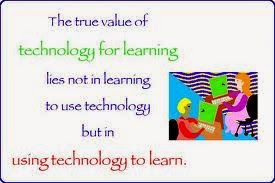Being a Special Education Facilitator in my rural school, this article peeked my interest since the topic surrounded AT for individuals with disabilities and ensuring equally accessible UDL spaces for all. In addition, I am always seeking current information about technology in today's diverse classrooms. Our school is just beginning to implement iPads into the classrooms for students with learning disabilities, visual impairments, autism and communication needs. We are extremely excited about this endeavour and want to do it successfully.
For me, this article helped to solidify my understanding of Assistive Technology and Universal Design for Learning. So, exactly what is AT and UDL?
"Assistive Technology (AT) is technology that increases, improves, or maintains the functional capabilities of students with disabilities. Usually it is specifically designed to assist individuals with disabilities in overcoming barriers in their environment and in increasing their opportunities for independence."
Universal Design for Learning (UDL) and its principles were originally intended to support architecture; ensuring buildings were accessible for all individuals prior to their conception regardless of whether or not they had a disability. "The focus of UDL is the learning environment rather than any particular student. Its purpose is to identify potential barriers to learning in a curriculum or classroom and to reduce such barriers through better initial designs, designs with the inherent flexibility to enable curriculum itself to adjust to individual learners."
A quick youtube video about UDL is included to further support the definition above.
Both these terms, AT and UDL, have been known to me, however, as I continue my educational journey I am learning that these two terms have overlapping goals and both are critical in education since both AT's and UDL's guiding principle is "increasing the access, participation, and progress of students with disabilities in our schools." This is exactly what our board and school is trying to do with the implementation of iPads for students with various needs.
One barrier that the authors of this article discussed in great detail was copyright laws that boards, schools and students are encountering when trying to access textbooks in a format other than print. For instance, a student trying to access a text book in braille in a timely manner. This barrier definitely hinders access for all students; therefore does not agree with UDL principles. Various organizations in the States have been established to better support and advocate for students with disabilities including The National Instructional Materials Accessibility Standard (NIMAS) and Individuals with Disabilities Education Act (IDEA). Both organizations recognized the powerful influence technology has for individuals with disabilities with regards to supporting their individual strengths and needs, accessing curriculum, fostering independence as opposed to dependence and being able to demonstrate their knowledge and skills. However, they also recognized that equal access to curriculum by students with disabilities was not happening in a timely manner and this was unacceptable.
Over the years, progress has been made. NIMAS and other partners have been working hard at paving the roadway for others to ensure that educational material for boards, schools and students are accessible to all its users, not just those with disabilities. Definitely a guiding UDL principle which is extremely important in the education system. According to the authors, more work is needed to ensure that "AT and UDL maturation and advancement develop symbiotically. When UDL and AT are designed to co-exist, learning for all individuals is enhanced."
Another youtube video is inserted to support the research and dialogue surrounding the statements that AT in the classrooms is making a difference; specifically the iPad, for both staff and students.



No comments:
Post a Comment